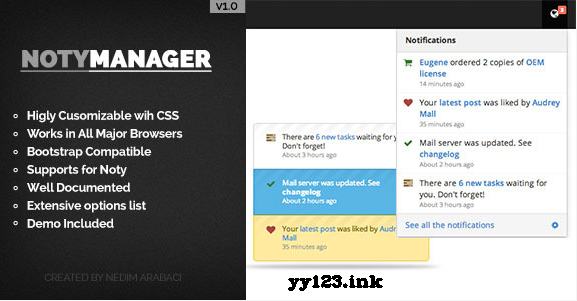初始化一个实例很简单其实,在下面可以看到// NotyManager initializationwindow.NotyManager = new $.NotyManager($("#notifications"), { bubble : { top : 10, left: -2, showZero: true }, max: 30, container: $("#notification-list"), wrapper: "
", emptyHTML: "
There is no notification in here
", callback: { onOpen: function() {}, onClose: function() {} }, useNoty: true, noty: { layout: "bottomLeft", timeout: false, closeWith: ["button"] }});下面列出了选项和默认值;// NotyManager initializationwindow.NotyManager = new $.NotyManager($("#notifications") /* this is the bubble attach element */, { // bubble options bubble : { top : 10, // default: 10 left: -2, // default: -2 showZero: true // default: false }, // max bubble count, if the count is bigger than 30 it will show 30+ max: 30, // default: 20 // this this the notification container container: $("#notification-list"), // default:
// this is the wrapper of the a single notification wrapper: "
", emptyHTML: "
There is no notification in here
", // default: as is callback: { // This callback is fired each time a notification list is opened onOpen: function() { // default: function(){} // NotyManager instance accessible with this variable in this scope console.log("opened", this); }, // This callback is fired each time a notification list is closed onClose: function() { // default: function(){} // NotyManager instance accessible with this variable in this scope console.log("closed", this); } }, // Below settings for the using open source Noty plugin // if true notifications also appears on the screen useNoty: true, // default: false // this settings used when if useNoty is `true` noty: { layout: "bottomLeft", // default: "bottomLeft" timeout: false, // default: false closeWith: ["button"] // default: ["button"] }});

dd:





 这篇博客介绍了如何使用NotyManager初始化一个通知管理器,详细列出了配置选项和默认值,包括气泡位置、最大显示数量、通知容器、包装器设置以及回调函数等。此外,还提到了当使用开源Noty插件时的特定设置。
这篇博客介绍了如何使用NotyManager初始化一个通知管理器,详细列出了配置选项和默认值,包括气泡位置、最大显示数量、通知容器、包装器设置以及回调函数等。此外,还提到了当使用开源Noty插件时的特定设置。
















 1万+
1万+

 被折叠的 条评论
为什么被折叠?
被折叠的 条评论
为什么被折叠?








